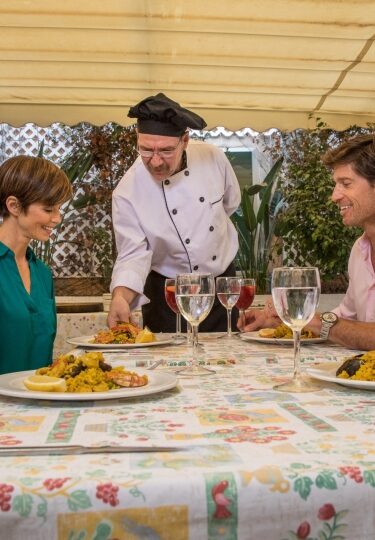For traveling gourmands, food in Spain is an absolute pleasure to discover. Spain boasts remarkable geographic and cultural diversity, which is reflected on the plate. Imagine seafood-centric tapas with plentiful vermouth in Barcelona, or Valencia’s famed paella. No matter which region you dine in, impeccably sourced ingredients are at the core of every dish.
In the past few decades, Spanish chefs scooped up Michelin stars with elaborate molecular gastronomy. Yet some of the best Spanish cooking is often the simplest. Few pleasures can compete with sipping a chilled cava while nibbling on slices of jamón Ibérico.
Food from Spain is above all a social affair, meant to be savored at a leisurely pace in excellent company.
Paella
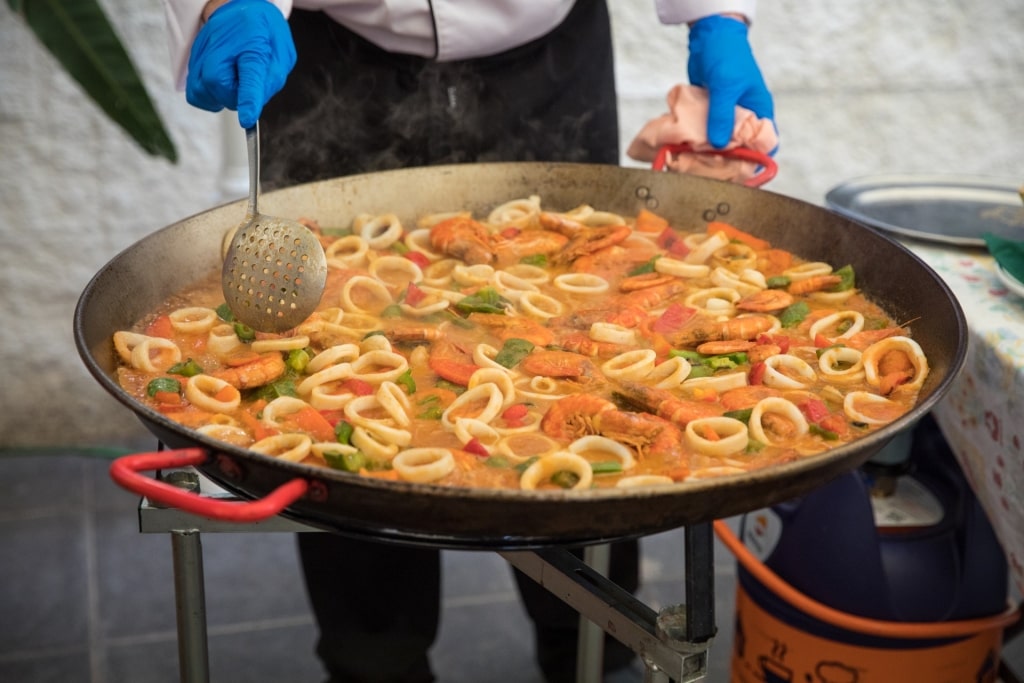
Paella
Although paella may be Spain’s best-represented culinary export abroad, it’s still far better enjoyed in its home country. Much of this has to do with the fact that Spain boasts not one paella, but many, many regional variations, each with their own appeal.
The term paella refers to rice that’s cooked, preferably over an open flame, in a large, shallow pan. That rather broad definition encompasses a tremendous range of ingredients and seasonings. Everything from snails to chorizo to wild game may be used, depending on the recipe.
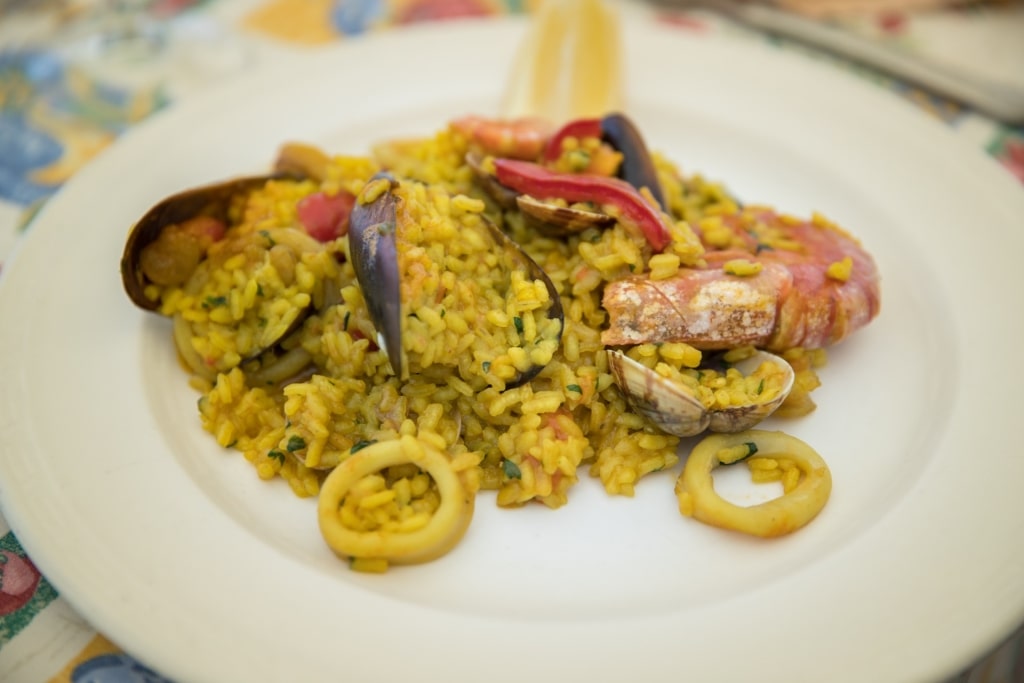
Paella
Arguably the most famous regional variation is paella Valenciana, which typically includes rabbit and chicken and is perfumed with saffron.
Paella de mariscos, or seafood paella, often includes mussels, prawns, squid, cod, and as many other types of seafood as the chef can muster. Oftentimes, this version is midnight black thanks to a glug of squid ink.
A few factors unite these seemingly disparate dishes. First of all, the backbone of every paella is a sofrito, finely minced and sauteed aromatics. Second, any paella worth its salt boasts a socarrat, a crunchy, toasty layer of cooked rice at the bottom.
Read: The Ultimate Valencia Food Guide
Jamón Ibérico
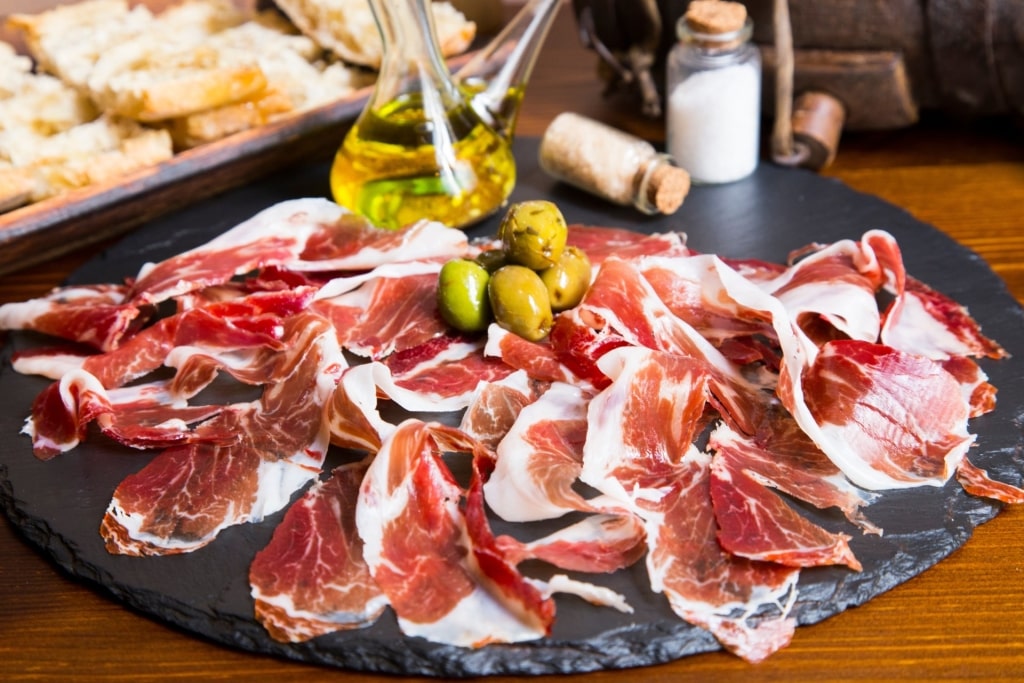
Jamón Ibérico
Jamón Ibérico is to your standard ham what a Ferrari is to a Fiat. This most prized Spanish ham is made with the legs of Black Iberian pigs. These heritage breed porkers feast on acorns, which gives their meat an especially rich, nutty flavor. Iberian pork also boasts an impressive amount of marbling, which gives this ham its silky, melt-in-your-mouth texture.
Of course, that kind of quality does not come cheap. Jamón Ibérico is treated and priced like a luxury item because it is. Experts often shave off wafer-thin slices off a whole leg by hand. A few slices are spectacular on a bocadillo (sandwich).
If you’re craving jamón but don’t want to splurge on the really good stuff, don’t worry. Jamón serrano is also utterly delicious and cured in the old, artisanal fashion, but lacks the price tag or the pedigree.
Tortilla Española
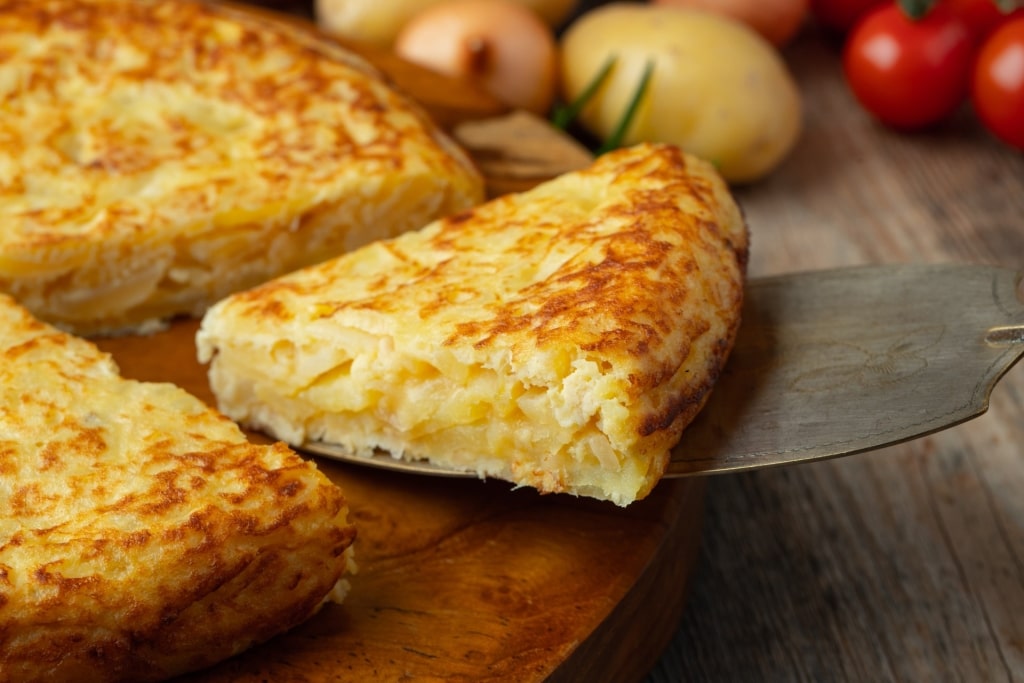
Tortilla española
Like many of Spain’s most iconic dishes, tortilla española is greater than the sum of its parts. While a dish consisting of eggs, potatoes, and onions seasoned with nothing more than salt and pepper might not sound especially flavorful, this one is.
The secret lies in the olive oil—lots and lots of olive oil. In a true tortilla, the thinly sliced rounds of potato are half-braised, half-fried in a generous pan of the good stuff. The result boasts a velvety texture that is simply not possible without that much fat. Once the eggs are added, this sophisticated frittata is cooked until bronzed on top.
It can be served warm or cold, sliced into wedges and accompanied by a dollop of aioli. Although tortilla espanola can stand alone, it is usually part of a larger tapas spread.
Gazpacho
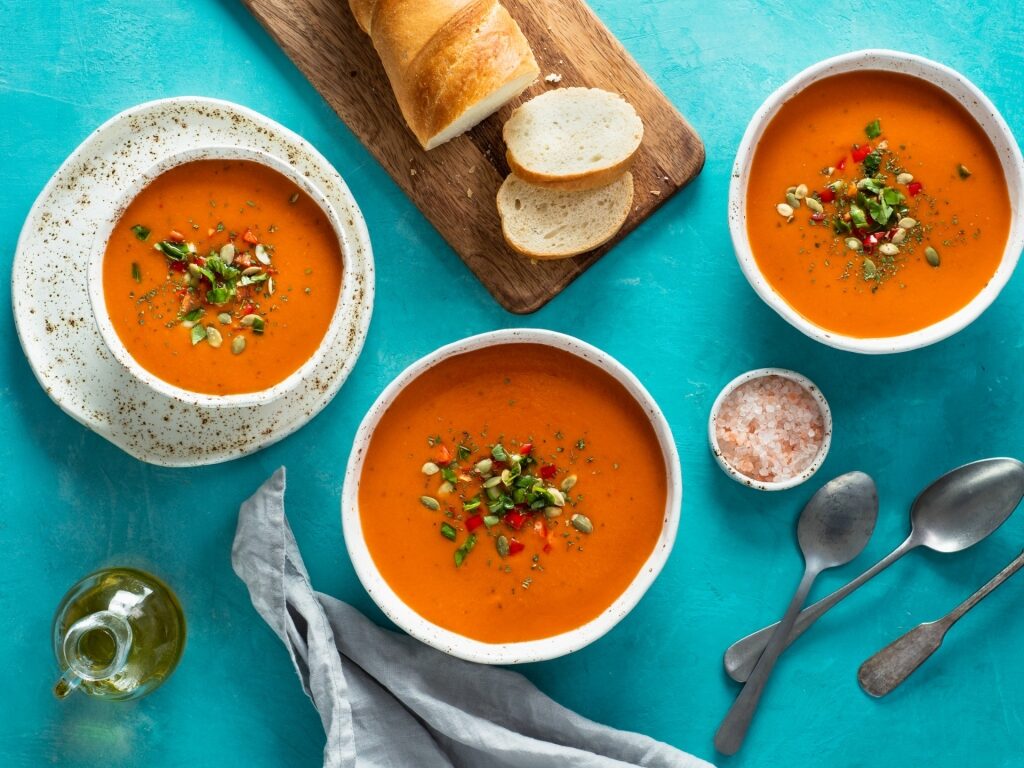
Gazpacho
This chilled soup tastes like summer in a bowl. A good gazpacho should be made with ripe, in-season tomatoes, bell peppers, cucumber, onion, and garlic all whirled together in a blender. A generous amount of extra virgin olive oil emulsifies the mixture and gives it a luxurious mouthfeel.
While tomato-based gazpacho is the most famous iteration of this soup, it’s not the only one. White gazpacho consists of grapes, cucumber, blanched almonds, bread, and olive oil pureed together. To the uninitiated, the ingredient list might not sound like much. Once combined, however, it’s deliciously smooth and refreshing on a hot afternoon.
To make matters more confusing, there’s salmorejo, another chilled tomato soup from Andalucia. Unlike gazpacho, which retains a bit of texture, this cold soup of soaked bread, tomatoes, and olive oil is pale orange and velvet-smooth.
Patatas Bravas
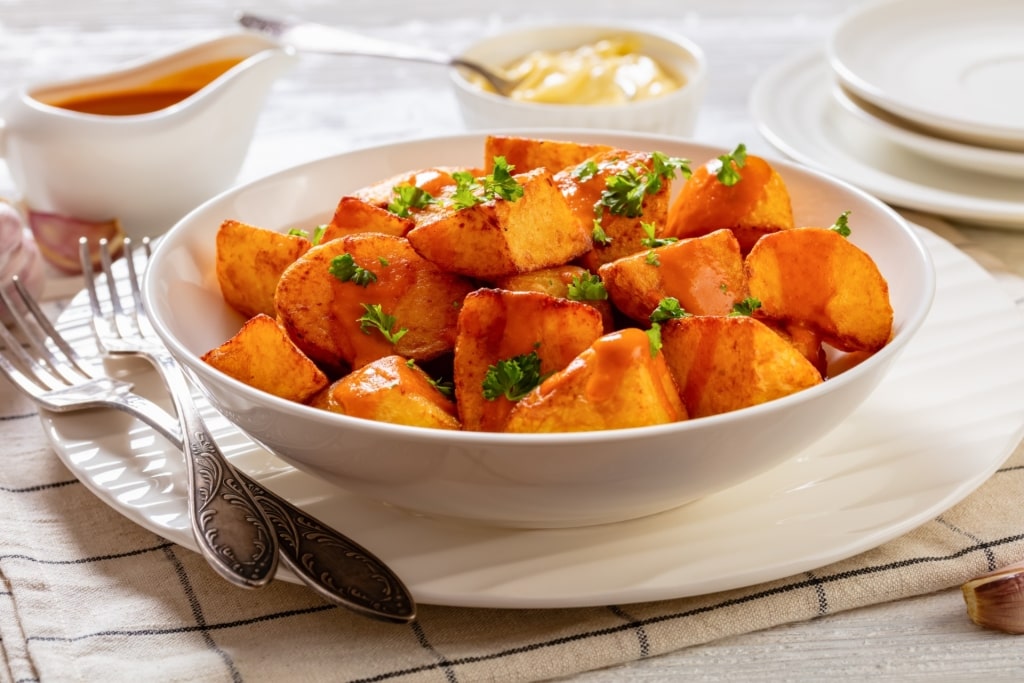
Patatas bravas
An essential component of any tapas spread that Spain is known for, patatas bravas are fried chunks of potatoes. Unlike more uniform French fries, bravas tend to come in irregular pieces with craggy, crispy edges.
A dusting of salt and smoked paprika make these utterly addictive. Like other forms of fried spuds, they are best served with a dipping sauce. In this case, it’s a garlicky aioli that often comes draped over the top.
Pimientos de Padrón
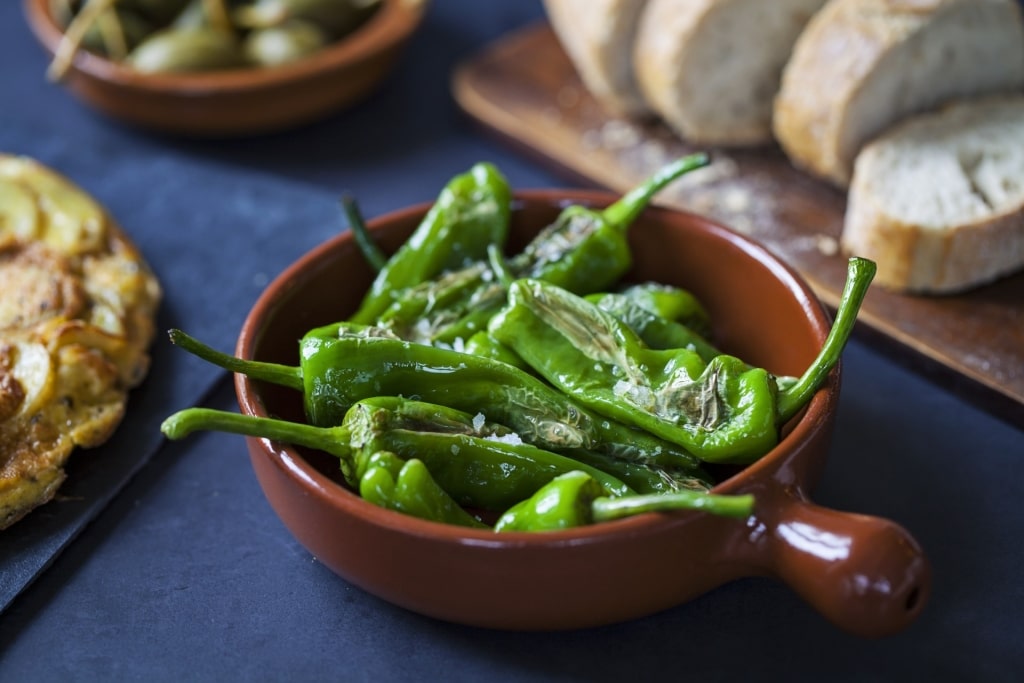
Pimientos de padrón
If you spot a plate of these blistered, green peppers on a tapas spread, beware. Yes, they’re salty, savory, and almost impossible to stop eating. A squeeze of citrus and a sprinkle of flaky salt transforms them into the ultimate bar snack.
But while most of these peppers are mild, every so often you may encounter a fiery specimen. Approximately one out of every 10 peppers packs the capsicum punch of a jalapeno. So approach with caution and come armed with a glass of Rioja or a chilled cerveza just to be safe.
Read: The Ultimate Mallorca Food Guide
Churros
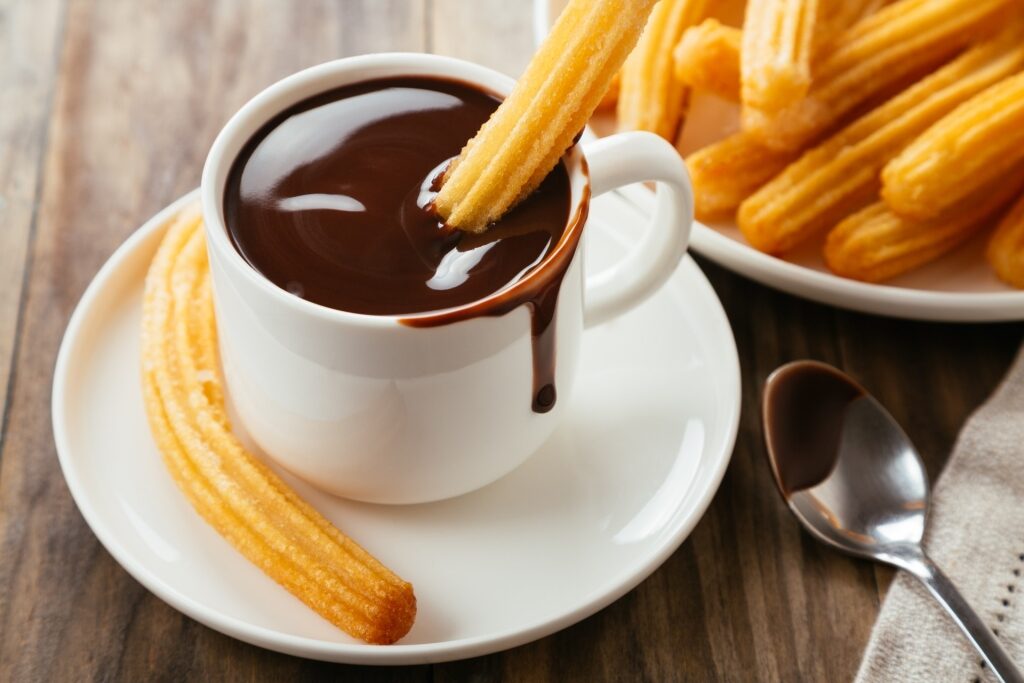
Churros
As with many fried foods, churros are best consumed while still piping hot. These batons are a delicious dessert or snack and enjoyed from morning until the wee hours.
Churros are made with an egg-rich dough extruded through a mold to form a distinctive ridged shape. After a quick stint in bubbling oil, they’re tossed in sugar and served immediately.
Possibly the most satisfying aspect of churros is dunking them in a thick, rich chocolate sauce. They also pair brilliantly with hot chocolate, a beverage the Spanish approach with borderline reverence.
Gambas al Ajillo
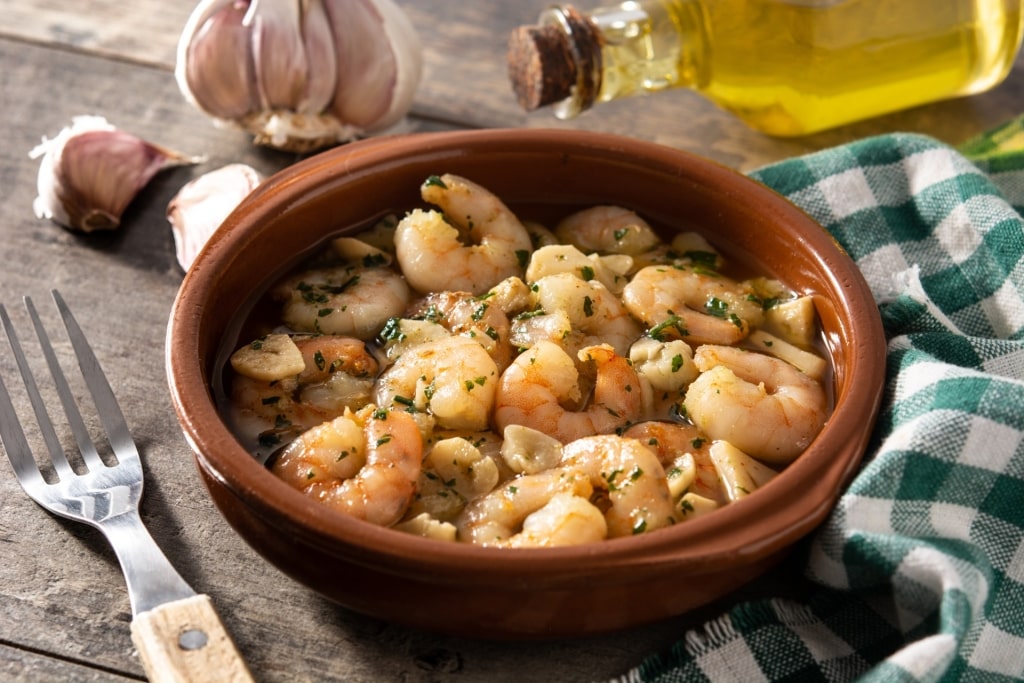
Gambas al ajillo
Spain’s spectacular seafood is on display in this elemental dish of prawns sauteed with copious amounts of garlic.
Any variety of shrimp tastes sensational with this preparation, but the fanciest versions rely on large, head-on prawns. A splash of wine or sherry vinegar often adds acidity, while smoked paprika or chili pepper flakes bring a sultry depth of flavor.
The finished dish often arrives still sizzling and showered with chopped parsley. A crusty piece of bread is an essential accompaniment for dunking in the fragrant sauce.
Pulpo a la Gallega
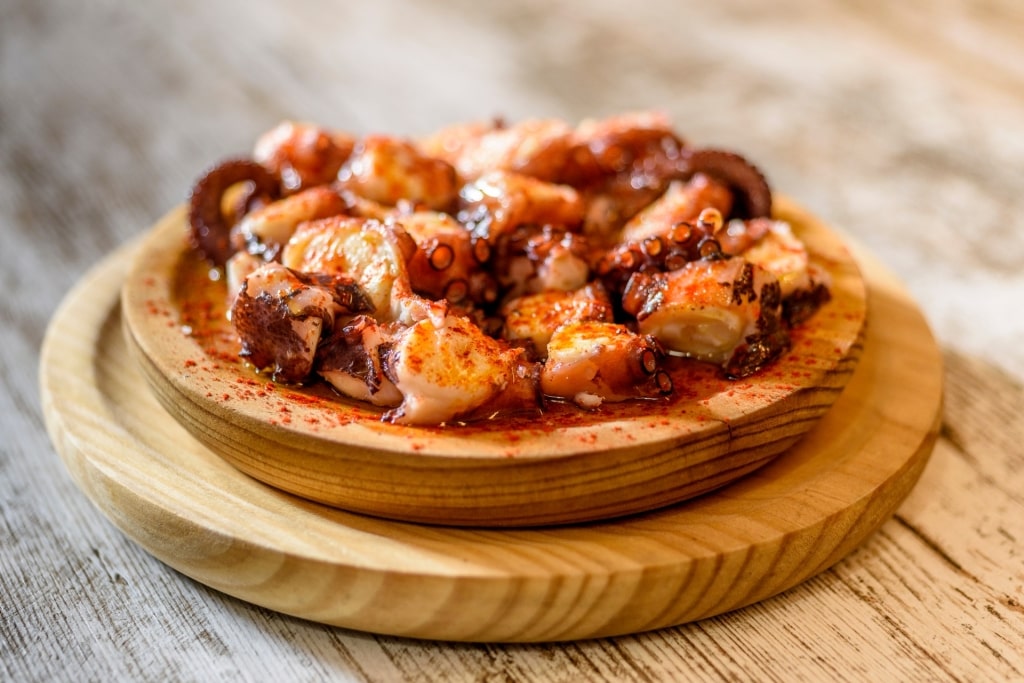
Pulpo a la gallega
Galician-style octopus, which is sometimes also referred to as polbo a feira, is a testament to how time and care can transform a few simple ingredients.
If poorly prepared, octopus can sometimes have a rubbery texture. The skilled cooks of Galicia, however, simmer the cephalopod until tender and pair it with boiled potatoes. Smoked paprika, flaky sea salt, and a drizzle of grassy olive oil round out the dish.
Pulpo a la Gallega is a popular food at festivals on the Iberian peninsula, but it can be enjoyed at tapas joints all over Spain.
Cochinillo Asado
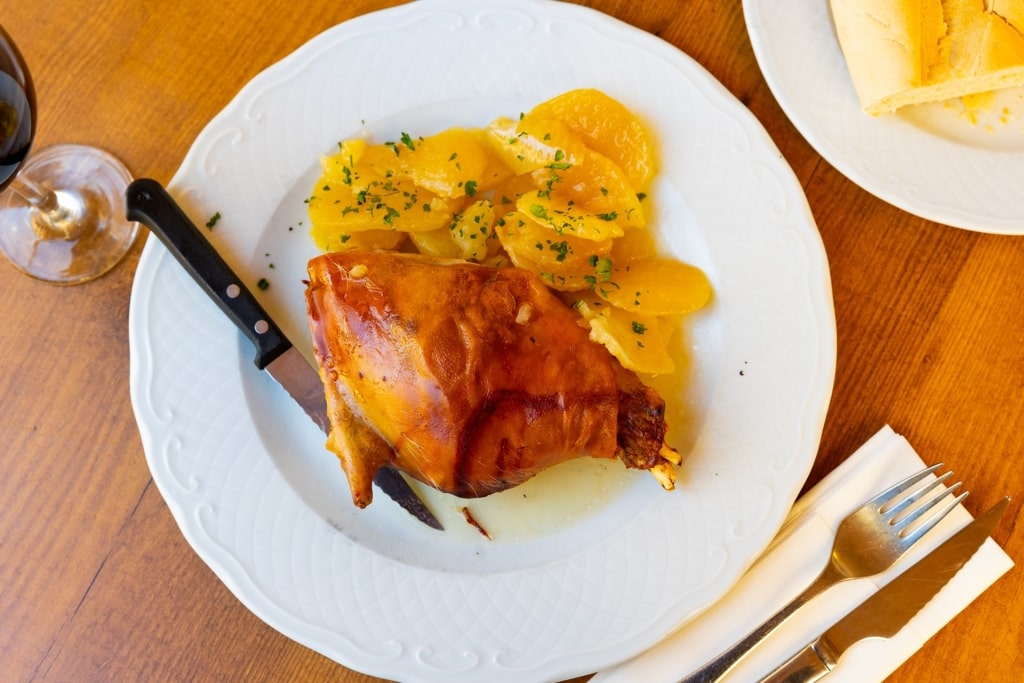
Cochinillo asado
Many cultures have their own rendition of whole-roasted suckling pig and cochinillo asado is Spain’s. Traditionally associated with Castille, it can be found all over Spain. As with any great whole-roasted pig, the secret to success lies in a live fire and plenty of time.
Hours of slow, consistent heat render the pig’s lard, leading to succulent meat and crispy skin. Since cochinillo asado requires considerable work, it’s usually reserved for holiday feasts. Nevertheless, some restaurants serve this delicacy all year-round.
Crema Catalana
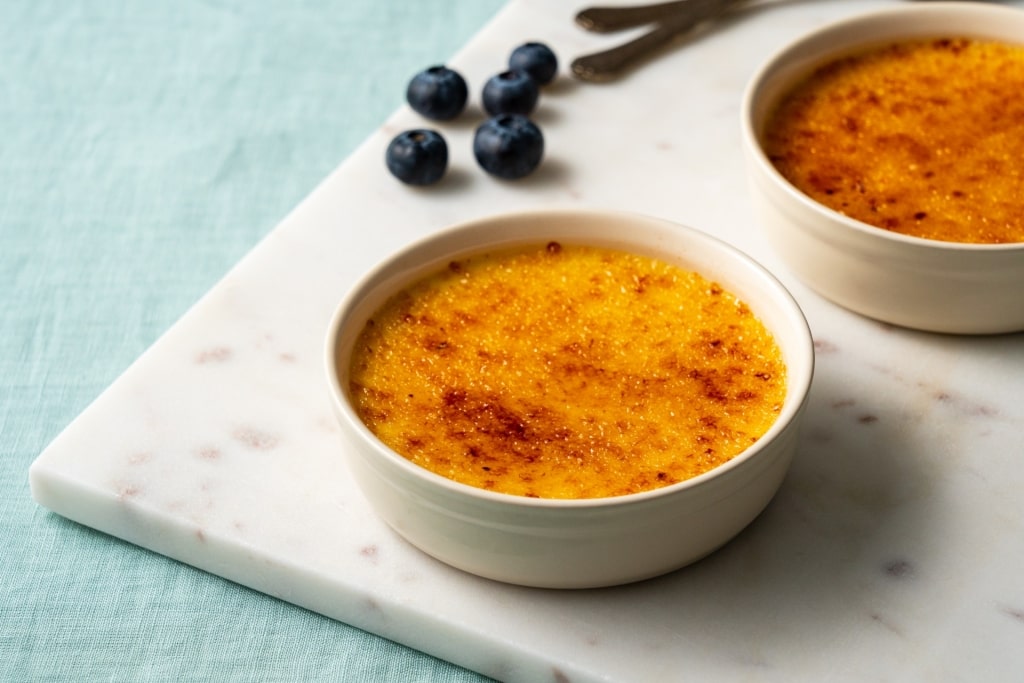
Crema catalana
This luscious custard belongs to the same sweet extended family as crème brûlée and flan. At first glance, these silky, creamy desserts might appear similar. Yet the techniques behind them and the results are noticeably distinct.
Unlike flan, which is baked in a water bath for a uniform texture, crema Catalana is made entirely in a saucepan on the stove. And unlike crème brûlée, which is made with heavy cream, it uses whole milk for a lighter consistency.
To make this custard, cooks simmer milk with cinnamon sticks, orange, and lemon zest until fragrant. Egg yolks, sugar, and cornstarch are then cooked together until thick and glossy. The whole mixture then gets chilled and served, like its French cousin, with blowtorched caramelized sugar on top.
Tarta de Santiago
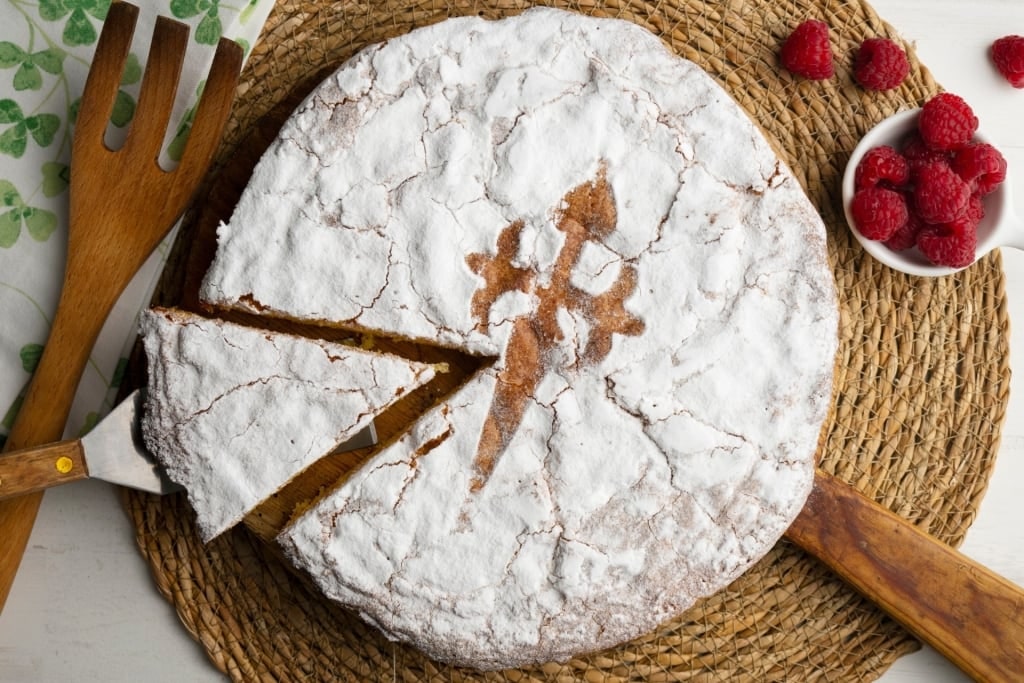
Tarta de Santiago
This fragrant almond cake is one of Galicia’s most iconic desserts. Recipes vary slightly, but consist of pulverized almonds, eggs, and sugar. Citrus zest and a splash of brandy are traditionally added for flavor. Some bakeries up the ante with a flaky pastry crust at the base. The result pairs as well with a glass of fortified wine as it does with an espresso.
During the Middle Ages, the Camino de Santiago was one of the most important Christian pilgrimage routes in Europe. Although it’s unlikely that Catholics journeying through Galicia enjoyed food quite this fine, there are records of this cake dating back to the 16th century.
In 1924, restaurateur Jose Mora Soto began stenciling the Cross of the Order of Santiago onto his cakes. He named them for the region’s most famous saint and the moniker “tarta de Santiago” stuck.
Bacalao al Pil Pil
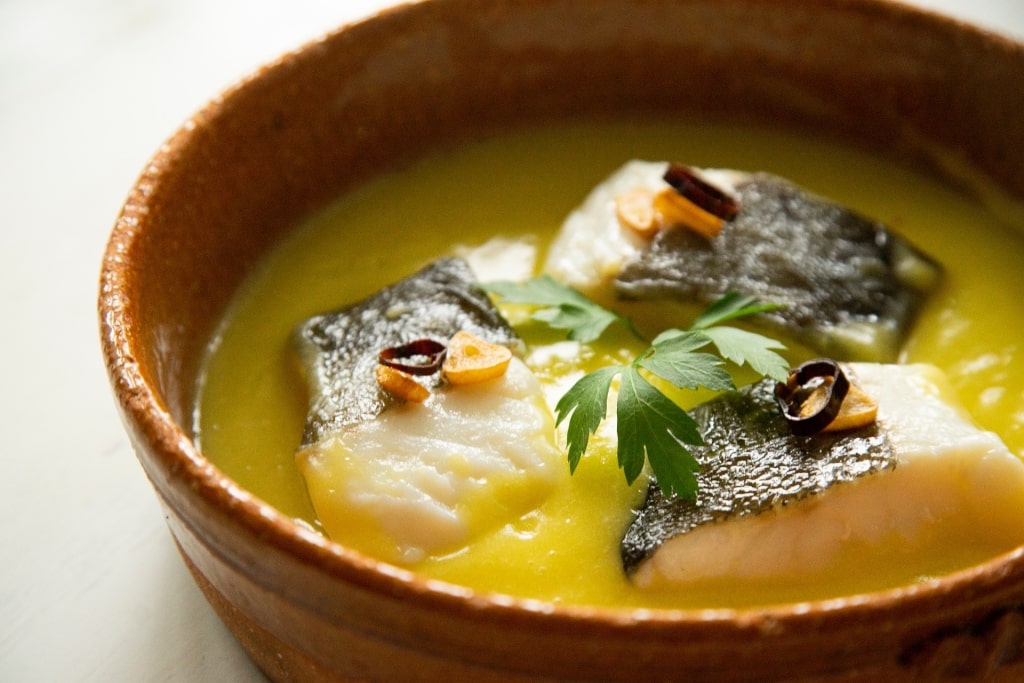
Bacalao al pil pil
Bacalao, or dried, salted cod, evolved as a means of food preservation in times before refrigeration. Because sailors historically relied on it for survival on long voyages, salt cod can now be found from Brazil and the Caribbean to Norway and much of the Mediterranean.
It remains a beloved staple throughout much of Spain. After being soaked for a day or two and rinsed, bacalao has only a mild salinity and a flaky texture.
Bacalao al pil pil hails from the Basque region originally, although many food historians believe its roots extend to North Africa. Like many Spanish classics, this dish relies heavily on technique to coax flavor out of a short list of ingredients.
To make the pil pil sauce, cooks infuse olive oil with garlic and a dried chili, then simmer the cod in it. Here’s where it gets interesting: the cook then uses the natural gelatin of the fish to emulsify the oil. The resulting sauce has the consistency of a runny aioli.
Croquetas
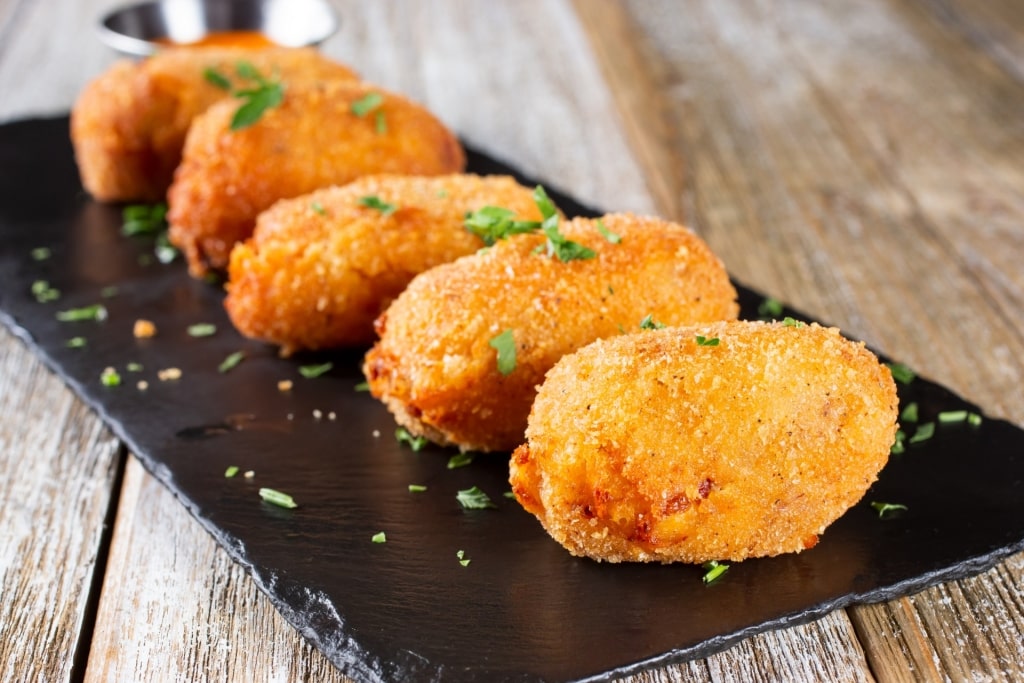
Croquetas
Along with patatas bravas and tortilla española, just about any tapas bar will offer up crunchy croquetas. These deep-fried nuggets have the most humble of origins. For Spanish home cooks, they were traditionally a way to use up leftovers. Just about any scraps of meat, seafood, or cheese could be bound together and transformed into a tasty snack.
Plenty of European cultures had the same thrifty idea, which is why we now have everything from Dutch kroketten to French croquettes. Modern-day tapas bars often incorporate fancier ingredients than yesterday’s leftovers. Croquetas de jamón (ham) and croquetas de bacalao (salt cod) are particularly popular options.
What sets Spanish croquetas apart from some of their counterparts is that they use a thick bechamel to bind the ingredients. That means that the crispy, breadcrumb exterior yields to a sumptuous fried interior and makes croquetas the ultimate comfort food in Spain.
Read: The Ultimate Barcelona Food Guide
Turrón
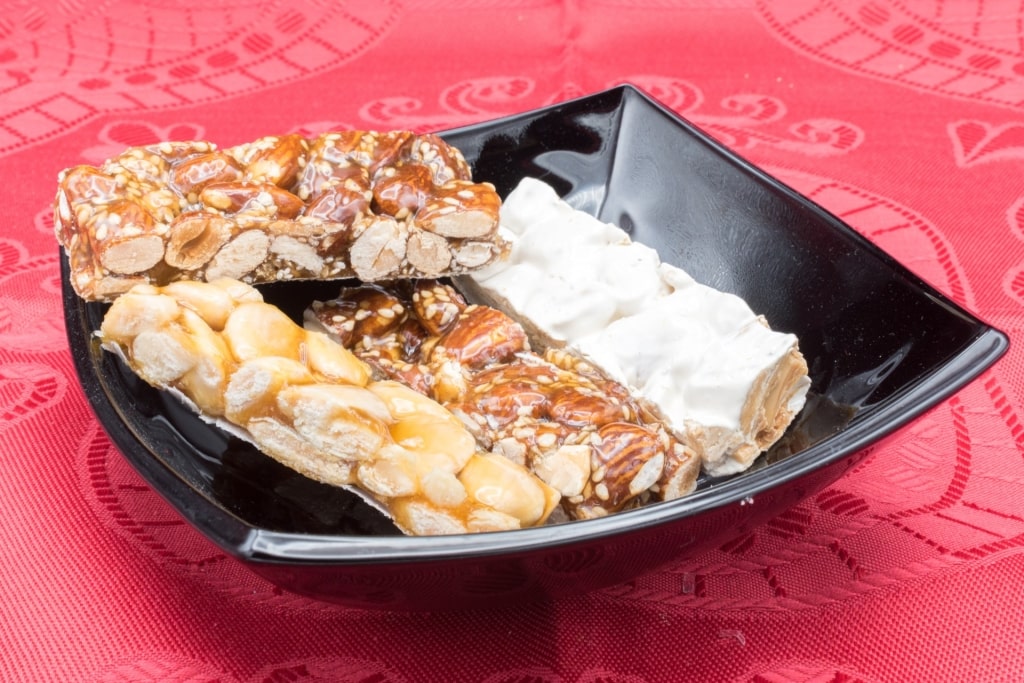
Turrón
Ever since the 15th century, confectioners in Spain have been whipping up this alchemical marvel of caramelized honey and egg whites. Heat and patience transform these ingredients into a crunchy, snow-colored nougat, which is usually studded with toasted nuts.
No one knows the precise origins of this sweet treat, but it’s popular throughout Spain, Italy, and Portugal. Some food historians believe that variations of the candy may date back to ancient Greece and Rome.
Today, it’s especially beloved around Christmas, although it can be enjoyed at any time of year. Since turrón keeps and travels well, it makes for a great edible Spanish souvenir or gift.

Restaurant in Palma de Mallorca
For travelers looking to sample the many culinary pleasures that Spain has to offer, there’s simply no better way to do so than by boarding a cruise with Celebrity. Browse our upcoming Spain cruises and book your next voyage today.
